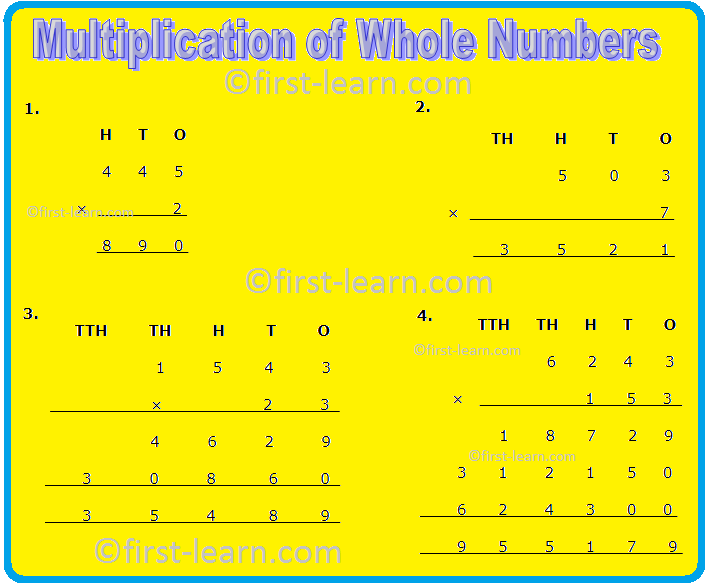Multiplication of Whole Numbers
Whole numbers are positive integers starting from zero and continues till infinity. We have already discussed with addition and subtraction of whole numbers. Now, we are here to discuss another basic operation with whole numbers that is multiplication of whole numbers.
Suppose let’s take an example:
1. 2 × 5 = 10
Again, 2+2+2+2+2 =10
2. 3 × 6 =18
3+3+3+3+3+3 = 18
What can be concluded from this?
Multiplication is nothing but actually repeated addition. When we are dealing with large numbers then repeated addition becoming time consuming, tiring and confusing as well. Hence we opt for multiplication as it becomes much easy than repeated addition.
Here are now few examples of multiplication of whole numbers
1.
H T O
4 4 5
× 2
8 9 0
The number in the first row that is 445 is called the multiplicand and 2 is called the multiplier. Now 2 is multiplied each time starting from the right side or ones place by every number. 2 is first multiplied with 5 to get 10. But we cannot write 10 hence we are writing 0 and 1 is carryover. Then again in the tens place 2 is multiplied with 4 to get 8 plus 1 carryover from the ones place so it becomes 9. Lastly 2 is again multiplied with 4 to get 8 and there is no carryover. The answer obtained that is 890 is called the product.
2.
TH H T O
5 0 3
× 7
3 5 2 1
Here 503 is the multiplicand and 7 is the multiplier and 3521 is the product. In the same way 7 is multiplied with 3 to get 21. We cannot write 21 so we are writing 1 and 2 carryover. Then again 7 is multiplied with 0 to get 0 plus 2 carryover. Lastly 7 is multiplied with 5 to get 35 and no carryover.
3.
TTH TH H T O
1 5 4 3
× 2 3
4 6 2 9
3 0 8 6 0
3 5 4 8 9
1543 is the multiplicand and 23 is the multiplier. Now in the same way as discussed above 1543 is the multiplicand is multiplied with the multiplier 3 to get 4269. Again, 1543 the multiplicand is multiplied with the multiplier 2 to get 3086. Lastly both 4629 and 30860 is added to get the final product 35489
4.
TTH TH H T O
6 2 4 3
× 1 5 3
1 8 7 2 9
3 1 2 1 5 0
6 2 4 3 0 0
9 5 5 1 7 9
6243 is the multiplicand and 153 is the multiplier. Now in the same way as discussed above 6243 is the multiplicand is multiplied with the multiplier 3 to get 18729. Again, 6243 the multiplicand is multiplied with the multiplier 5 to get 31215. 6243 is multiplied with 1 to get 6243. Lastly all the three are added to get 955179.
From Multiplication of Whole Numbers to HOME PAGE
Recent Articles
-
Explain about Growth in Plants |Definition of Growth & Differentiation
Feb 27, 25 02:07 PM
Growth is a permanent increase in length or volume of an organism that brought upon by an increase in its dimensions due to synthesis of new protoplasmic material. -
Definition of Respiratory Quotient | calculation | Application | Plant
Dec 02, 24 12:09 AM
Definition of respiration quotient- the ratio of the carbon-dioxide evolved to that of the oxygen consumed by a cell, tissue, plants or animals in a given time is called respiratory quotient. It is us… -
Amphibolic Pathway | Definition | Examples | Pentose Phosphate Pathway
Jun 06, 24 10:40 AM
Definition of amphibolic pathway- Amphibolic pathway is a biochemical pathway where anabolism and catabolism are both combined together. Examples of amphibolic pathway- there are different biochemical… -
Respiratory Balance Sheet | TCA Cycle | ATP Consumption Process
Feb 18, 24 01:56 PM
The major component that produced during the photosynthesis is Glucose which is further metabolised by the different metabolic pathways like glycolysis, Krebs cycle, TCA cycle and produces energy whic… -
Electron Transport System and Oxidative Phosphorylation | ETC |Diagram
Feb 04, 24 01:57 PM
It is also called ETC. Electron transfer means the process where one electron relocates from one atom to the other atom. Definition of electron transport chain - The biological process where a chains…





New! Comments
Have your say about what you just read! Leave me a comment in the box below.